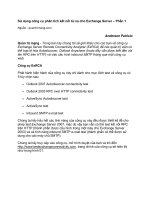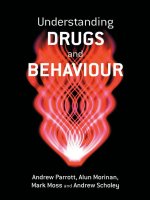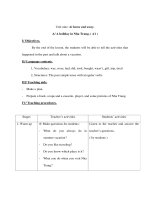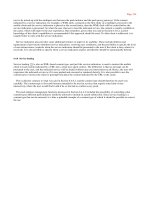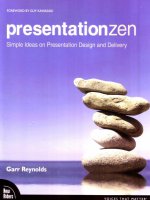Understanding Drugs and Behaviour phần 1 docx
Bạn đang xem bản rút gọn của tài liệu. Xem và tải ngay bản đầy đủ của tài liệu tại đây (539.4 KB, 34 trang )
Understanding
Drugs and
Behaviour
Andrew Parrott
Department of Psychology, University of Wales Swansea,
Swansea, UK
Alun Morinan
School of Health & Bioscience, University of East London,
London, UK
Mark Moss
Division of Psychology, Northumbria University,
Newcastle-upon-Tyne, UK
Andrew Scholey
Division of Psychology, Northumbria University,
Newcastle-upon-Tyne, UK
Understanding Drugs
and Behaviour
Understanding
Drugs and
Behaviour
Andrew Parrott
Department of Psychology, University of Wales Swansea,
Swansea, UK
Alun Morinan
School of Health & Bioscience, University of East London,
London, UK
Mark Moss
Division of Psychology, Northumbria University,
Newcastle-upon-Tyne, UK
Andrew Scholey
Division of Psychology, Northumbria University,
Newcastle-upon-Tyne, UK
Copyright # 2004 John Wiley & Sons Ltd, The Atrium, Southern Gate, Chichester,
West Sussex PO19 8SQ, England
Telephone (þ44) 1243 779777
Email (for orders and customer service enquiries):
Visit our Home Page on www.wileyeurope.com or www.wiley.com
All Rights Reserved. No part of this publication may be reproduced, stored in a retrieval
system or transmitted in any form or by any means, electronic, mechanical, photocopying,
recording, scanning or otherwise, except under the terms of the Copyright, Designs and
Patents Act 1988 or under the terms of a licence issued by the Copyright Licensing Agency
Ltd, 90 Tottenham Court Road, London W1T 4LP, UK, without the permission in writing of
the Publisher. Requests to the Publisher should be addressed to the Permissions Department,
John Wiley & Sons Ltd, The Atrium, Southern Gate, Chichester, West Sussex PO19 8SQ,
England, or emailed to , or faxed to (þ44) 1243 770620.
This publication is designed to provide accurate and authoritative information in regard to
the subject matter covered. It is sold on the understanding that the Publisher is not engaged
in rendering professional services. If professional advice or other expert assistance is
required, the services of a competent professional should be sought.
Other Wiley Editorial Offices
John Wiley & Sons Inc., 111 River Street, Hoboken, NJ 07030, USA
Jossey-Bass, 989 Market Street, San Francisco, CA 94103-1741, USA
Wiley-VCH Verlag GmbH, Boschstr. 12, D-69469 Weinheim, Germany
John Wiley & Sons Australia Ltd, 33 Park Road, Milton, Queensland 4064, Australia
John Wiley & Sons (Asia) Pte Ltd, 2 Clementi Loop #02-01, Jin Xing Distripark, Singapore 129809
John Wiley & Sons Canada Ltd, 22 Worcester Road, Etobicoke, Ontario, Canada M9W 1L1
Wiley also publishes its books in a variety of electronic formats. Some content that appears in print may not
be available in electronic books.
Library of Congress Cataloging-in-Publication Data
Understanding drugs and behaviour / Andrew Parrott [et al.].
p. cm.
Includes bibliographical references and index.
ISBN 0-470-85059-0 (cloth : alk. paper) – ISBN 0-471-98640-2 (pbk. : alk. paper)
1. Psychopharmacology. 2. Drugs of abuse. 3. Drugs. I. Parrott, Andrew.
RM315.U45 2004
615
0
.78 – dc22 2004000221
British Library Cataloguing in Publication Data
A catalogue record for this book is available from the British Library
ISBN 0-470-85059-0 (hbk)
ISBN 0-471-98640-2 (pbk)
Project management by Originator, Gt Yarmouth, Norfolk (typeset in 10/12pt Times and Stone Sans)
Printed and bound in Great Britain by Antony Rowe Ltd, Chippenham, Wiltshire
This book is printed on acid-free paper responsibly manufactured from sustainable forestry
in which at least two trees are planted for each one used for paper production.
For Felicity, Rebecca and Laura
For Mary, Ciara
´
n and Gareth
For Holly Mae
For Lola
Contents
About the authors ix
Preface xi
Part I Drugs and Their Actions 1
1 Psychoactive drugs: introduction and overview . 3
2 The brain, neurons and neurotr ansmission 9
3 Principles of drug action . 25
Part II Non-medical Use of Psychoactive Drugs 39
4 CNS stimulants: amphetamine, cocaine and caffeine . . . . 41
5 Nicotine and cigarette smoking 55
6 LSD and Ecstasy/MDMA 71
7 Cannabis . 85
8 Heroin and opiates . . . . . 103
9 CNS depressants: alcohol, barbiturates and
benzodiazepines 119
10 Alcoholism and drug dependence. . . 133
Part III Clinical and Medicinal Use of Drugs 151
11 Antipsychotics for schizophrenia . . . 153
12 Antidepressants and mood stabilisers 171
13 Nootropics for Alzheimer’s disease . 187
14 Cognitive enhancers . . . . 203
Part IV Final Overview 219
15 Current knowledge and future possibilities 221
Glossary 235
Key psychop harmacology and addiction journals 251
Internet sources of information about psychoactive drugs 253
References 257
Index 291
About the authors
Andy Parrott has published over 300 journal articles and conference
papers, covering a wide range of psychoactive drugs. The first
publications from his PhD at the University of Leeds were concerned
with antipsychotic medications. Then, as a postdoctoral researcher
with the Human Psychopharmacology Research Unit at Leeds Uni-
versity, he investigated the effects of second-generation antidepres-
sants and benzodiazepines on cognitive performance and car-driving
skills. Moving to the Institute of Naval Medicine in Hampshire, he
was tasked with determining the practical utility of anti-seasickness
medications, such as transdermal scopolamine, in land and sea trials.
Further trials investigated the cognitive side effects of nerve agent
prophylactics. At the University of East London he established the
Recreational Drugs Research Group, which investigated a number
of disparate topics: caffeine in shift workers, anabolic steroids in
weightlifters, amphetamine and LSD in party goers and nootropics
as potential ‘‘smart drugs’’. At Humboldt State University in
California, he assessed the everyday functioning of excessive
cannabis users. However, his two main research areas are nicotine
and MDMA/Ecstasy. In an extensive research programme he has
shown how nicotine dep endency is psychologically damaging and
causes increa sed psychological distress. The Recreational Drugs
Research Group which he founded at the University of East
London is, however, most well known for its work with recreational
MDMA/Ecstasy users. Their cognitive research papers have been
awarded the British Association for Psychopharmacology Organon
prize on two occasions. Professor Parrott’s work is featured regularly
in the media. He sits on the editorial boards of leading psychophar-
macology journals, and he has organised a number of international
symposia. Recently, he moved to the University of Wales at
Swansea. Here, he is continuing with a number of collaborative
studies, including a large UK/US prospective study investiga ting
the effects of recreational drug use during pre gnancy.
Alun Morinan graduated in Biochemistry from the University of
Wales at Aberystwyth and went on to complete an MSc in
Pharmacology at the University of London and a PhD in Neuro-
pharmacology at the National University of Ireland in Galway.
After postdoctoral research in Pharmacology at Galway and Bio -
chemistry at the Institute of Psychiatry, he was appointed Lecturer
in Pharmacology at North East Surrey College of Technology before moving to his
current post of Principal Lecturer at the University of East London. His publications
have been mainly in the fields of experimental psychopharmacology and neuro-
chemistry covering topics such as alcohol dependence, anxiety, schizophrenia and
enzymology.
Mark Moss studied applied chemistry and spent 10 years in industry before returning to
university to study Psychology. He completed his PhD in 1999 and was involved in the
establishment of the Human Cognitive Neuroscience Unit at Northumbria University.
His research portfolio has focused primarily on aspects of cognitive functioning in
healthy young volunteers, with journal articles and conference presentations relating
to both enhancement through natural interventions and drug-induced impairments.
Mark is currently programme leader for the Division of Psychology at Northumbria
University.
Andrew Scholey is a Reader in Psychology at the Division of Psychology, Northumbria
University, Newcastle-upon-Tyne. He has published hundreds of journal articles and
conference papers, covering the cognitive effects of many recreational and medicinal
drugs. His PhD and postdoctoral fellowship at the Brain and Behaviour Research
Group, Open Un iversity, examined the neurochemical substrates of memory formation.
He moved to Northumbria University in 1993, where his research has concentrated on
the acute and chronic impairing and enhancing effects of various drugs including
benzodiazepines, alcohol, caffeine, glucose, oxygen (with Mark Moss) and herbal
extracts. In 1999 Andrew establ ished the Human Cognitive Neuroscience Unit, of
which he is the director. The work of this unit concentrates on the potential for non-
mainstream treatments to enhance cognitive performance. These have ranged from
metabolic interventions (notably glucose and oxygen) to low doses of alcohol and
even to drinking water (in thirsty individuals) and to chewing gum. Andrew is also
the co-director of the Medicinal Plant Research Centre. His present focus of research
aims to disentangle the neurocognitive effects of herbal extracts, to attempt to identify
relationships between their behavioural effects and their neurochemical properties and
to identify safe treatments that may be effective in the treatment of conditions where
cognition becomes fragile, including dementia. He is currently involved in trials
examining the effects of herbal extracts in Alzheimer’s disease. Andrew is also com-
mitted to the public dissemination of science which has led to numerous appearances in
the print, radio and television media.
x About the authors
Preface
Drugs are a crucial part of modern society. Many are used for
recreational purposes, with alcohol, nicotine and caffeine all being
legal. However, others are illegal, and they include cannabis, Ecstasy,
cocaine and heroin. In the past 50 years a number of medicinal
compounds have been developed for schizophrenia, depression and
other clinical disorders. They have dramatically improved the well-
being of many people diagnosed with these disorders. But what
exactly are the effects of these different types of drug? How precisely
do they alter behaviour? How is it that such small chemicals can have
such dramatic effects on mood and cognition, sensation and aware-
ness, health and well-being? Why are only some drugs highly addic-
tive? Our core aim is to provide detailed answers for all these
questions.
We hope this book will not only be of interest to students of
psychology, behavioural sciences, health sciences and nursing but
also to undergraduates of physiology and pharmacology who wish
to find out more about the behavioural aspects of drug use. Our aim
throughout is to present the material in a reader-friendly fashion. We
have taught undergraduates in many different disciplines and have
therefore become skilled at explaining this material to students
without any formal scientific background. We will describe how
psychoactive drugs can alter brain chemistry and, hence, modify
behaviour. We offer an accessible route through basic aspects of
brain organisation and functioning. Normally, these areas are diffi-
cult for many unde rgraduate student s. However, by approaching
them through the mechanisms of drug action, we hope to stimulate
an active interest in this area.
We have planned every chapter to be self-contained. Each
commences with a general overview, before the core material is
presented in depth; this is followed by a list of questions that
should prove useful for both students and their lecturers. Finally,
there are several key articles, followed by a list of further references.
Many of the chapters in this book have been tested out on our
students. Not only did they report that the chapters were all excellent
(in feedback sessions that were obviously not blind!) they also in-
formed us that they particularly liked this reference format. They
found it useful when writing essays, preparing projects and, most
importantly, when ‘‘cramming’’ for exams.
In terms of its ov erall structure, we have focused on the main types of drug used in
society. Thus, alcohol and nicotine have chapters largely dedicated to them. Similarly,
there is a whole chapter on cann abis, while another is shared by LSD and Ecstasy/
MDMA. We also cover opiates, such as heroin, and CNS stimulants, such as amphe-
tamine and cocaine. Turning to drugs for clinical disorders, one chapter is dedicated to
antipsychotic medications for schizophrenia, while another covers antidepressant
drugs. We also look at more novel areas, such as drugs for Alzheimer’s disease, as
well as nootropics and herbal preparations to improve cognitive functioning. In every
chapter we have focused not only on drug effects but also on how these interact with
environmental factors. We have also noted how drugs often need to be combined with
psychological therapy to achieve the optimal clinical outcome.
One of the benefits of working as a team of four co-authors is that between us we
have a great deal of knowledge about all aspects of drugs and behaviour. Thus, every
chapter is informed by a high level of research expertise. Indeed, in several fields the
authors are leading international research authorities. We believe that drugs are not
only very important for society but also v ery fascinating in their own right. Certainly,
they have intrigued us for many years, and we hope to pass on some of this interest and
fascination to our readers.
Andy Parrott
Alun Morinan
Mark Moss
Andy Sch oley
Universities of Swansea, East London and Northumbria
xii Preface
PART I
Drugs and
Their Actions
1 Psychoactive drugs: introduction and
overview
3
2 The brain, neurons and
neurotransmission
9
3 Principles of drug action 25
Chapter 1
Psychoactive drugs:
introduction and
overview
Overview
P
sychoactive drug use is not just a phenomenon of the 20th
century; many different types of drug have been used throughout
recorded history. In this chapter we will outline the main classes of
psychoactive drug. We are able to do this in a single chapter
because, despite there being thousands of different drugs, they can
be classified in a few main groups (Table 1.1). The crucial role of
neurotransmitters will also be described because psychoactive drugs
alter mood and behaviour by modifying nerve activity in various
ways. Thus, a basic understanding of neurotransmitter actions is vital
in order to understand how drugs can affect behaviour. Tolerance
and addiction may also develop, when regular drug use causes long-
term changes in neurotransmission activity. Next, we will emphasise
that all drugs have a range of positive and negative behavioural
effects. Positive or desirable effects, such as feelings of pleasure, are
the reasons people take drugs. But drugs also cause negative effects,
which is why drug taking can cause so many psychosocial problems.
Psychoactive drugs over the ages
Since before the dawn of civilisation, humans have used drugs
1
to
alter their mood and behaviour. Opium poppy (Papaver somniferum)
seeds have been found by archaeologists in Neolithic burial sites.
Some of the earli est writing on clay tablets from Mesopotamia
described laws to control the alcohol consumption in local taverns.
Many societies have discovered that different species of plant and
fungi can induce powerful hallucinations. Native Americans have
used the peyote cactus (Lophophora williamsii) (containing
mescaline) to foster spiritual insights during their religious
ceremonies. Vikings used the Amanita muscaria mushroom for its
hallucinogenic and excitatory effects, before raiding and pillaging
1
Boldface terms are defined in the Glossary.
in their longboats. In ancient Greece, Homer’s epic poem Odysseus descri bes how the
hero and his crew were drugged by the sorceress Circe, a skilled ‘‘polypharmakos’’, or
drug user, who laced their wine with drugs that stunned their memories and ensnared
their minds. The wary Odysseus managed to avert this only be cause he had taken the
precaution of taking an antidote beforehand (Caldwell, 1970; Palfai and Jan kiewicz,
1996).
Many drugs are taken for their curative or medicinal effects. In South American
silver mines, for many centuries the miners have chewed coca leaves (containing
cocaine), to aid their physical and mental vigilance working high in the oxygen-poor
Andes (Chapter 4). Tea, which contains caffeine, was recommended as a general tonic
by sages in Ancient China (Chapter 4). In the Indian subcontinent the Indian snake
root Rauwolfia serpentina was used as a treatment for people suffering manic
excitement, or hallucinations and delusions. Its effecti veness at reducing the
symptoms of schizophrenia has been scientifically confirmed in the 20th century.
Rauwolfia contains reserpine, a powerful psychoactive drug that depletes dopamine
stores; this is how it leads to calmer and more manageable behaviour. In some ways,
reserpine displays properties similar to more modern antipsychotic drugs. However, its
broad spectrum of effects in deleting the stores of several neurotransmitters means that
it can also cause feelings of severe depression. Thus, reserpine is not used clinically,
since modern antipsychotic drugs do not have this unwanted side effect (Chapters 3
and 11).
Psychoactive drug use remained popular throughout the 20th century. Several
drugs are legal, and their use has grown during the past 100 years. The advent of
machines to produce cigarettes at the beginning of the 20th century led to a marked
increase in tobacco consumption. By the end of the second world war, helped by the
free distribution of cigarettes to the armed forces, around 70% of the male population
in the UK were regular nicotine users. In global terms the world consumption of
4 Part I Drugs and Their Actions
Table 1.1. Psychoactive drug groups.
Chapter Drug group Main properties Examples
4 CNS stimulants Increase alertness, intensify Amphetamine, cocaine, caffeine
moods
5–7 Recreational drugs Various disparate effects Nicotine, cannabis, LSD,
MDMA
8 Opiates Reduce pain, increase Heroin, morphine, codeine
pleasure
9–10 CNS depressants Increase drowsiness, relax Alcohol, barbiturates,
moods benzodiazepines
11 Antipsychotics Reduce hallucinations and Chlorpromazine, haloperidol,
delusions clozapine
12 Antidepressants Relieve sadness and Imipramine, fluoxetine
depression
13 Nootropics Slow cognitive decline in Aricept, tacrine
dementia
3, 14 Other drug types Various disparate effects Herbal and other medications
tobacco is still increasing, despite reductions in a few Western countries where its
adverse health effects have been emphasised. Yet, even where marked reductions
have occurred, particularly in the USA, Britain and Australia, this decrease in con-
sumption has not been maintained. Recent years have shown a resurgence of cigarette
smoking among the young, particularly adolescent females (Chapter 5). Alcohol use
also shows no sign of reduction, and at the same time the age of first drinking continues
to fall. In the USA many high schools offer formal programmes to help their teenage
pupils to quit smoking, or reduce excessive alcohol consumption (Chapters 9 and 10).
Another legal drug – caffeine – is consumed by over 90% of the adult population in
their daily tea and coffee. Caffeine is also present in the fizzy soft drinks and chocolate
bars consumed by children each day (Chapter 4). Many other psychoactive drugs are
deemed illegal, yet even the threat of long prison terms does not halt their popularity.
Around 50 million Americans have smoked cannabis (marijuana), although only
49,999,999 admit to inhaling since former President Bill Clinton admitted to having
tried marijuana but without inhaling! (Chapters 7 and 15). The use of amphetamine,
cocaine and heroin has increased in recent decades, while new recreational drugs have
also been specifically ‘‘designed’’ for their mood-altering effects (Shulgin, 1986). Ecstasy
(MDMA, or methylenedioxymethamphet amine) first became popular in the mid-1980s
and since then its use has steadily increased, with young people trying it at an increas-
ingly early age (Chapter 6).
One of the most dramatic changes for modern society was the advent of effective
psychoactive medicines in the 1950s. The first antipsychotic drug chlorpromazine was
developed in 1950, and since then the management and treatment of schizophrenia has
been transformed, with most patients now seen as outpatients and the majority of
‘‘mental hospitals’’ being closed (Chapters 11 and 15). The advent of antidepressant
drugs in 1957 led to a similar change in the treatment of people suffering from
depression (Chapter 12). Thus, we now have a range of drug treatments for two of
the most severe psychiatric disorders. It should be emphasised that the advent of these
drugs has not been entirely beneficial. Numerous schizophrenics now suffer greatly,
because society has failed to provide the support mechanisms. Antipsychotic drugs
are only partially effective on their own. To maximise their effectiveness, they need to
be complemented by behavioural therapy, or social skills training. This is expensive,
and in most Westernised countries this support structure is generally lacking. Another
contentious area is the treatment of ‘‘hype ractive’’ young children with CNS (central
nervous system) stimulant drugs. The clinical diagnosis of Attention Deficit Hyper-
activity Disorder (ADHD) is a very recent phenomenon, but since the early 1980s an
increasing number of young children have been given this diagnosis. Is it defensible to
label continuous fidgeti ng or poor concentration on school work as clinical symptoms
in 5 and 6-year-olds and then administering them with powerful psychoactive drugs,
especially when it is the parents and teachers who are ‘‘suffering’’ the most? This issue
will be critically examined in Chapter 4. Pharmaceutical companies are now attempting
to develop nootropic drugs for Alzheimer’s disease and other disorders associated with
ageing (Chapter 13). If effective drugs for the elderly are successfully developed, the
impact on society could become even more marked than was the development of
antipsychotic and antidepressant drugs in the 1950s. Finally, there have been
numerous attempts to produce cognitive enhancers that modulate cell metabolism
and brain activity in various ways (Chapter 14).
Psychoactive drugs: introduction and overview 5
How many types of psychoactive drug are there?
There are hundreds of different drugs that can affect mood and behaviour, although
they can be categorised into a few basic drug types. Table 1.1 outlines the main
categories of psychoactive drug. This classification system also reflects their psycho-
pharmacological effects. Thus, CNS-stimulant drugs, such as amphetamine and
cocaine, generate feelings of alertness and lead to faster behavioural responses;
indeed, this is why they are banned in sport (Chapter 4). CNS-depressant drugs
generate feelings of sleepiness and impair skilled psychomotor performance; this is
why piloting a plane or driving a car are so dangerous under the influence of
alcohol, with numerous road deaths being caused each year (Chapter 9). Opiate
drugs, like heroin and morphine, are again similar in their effects, leading to feelings
of euphoria and reduced pain, in relation to both physical and mental pain (Chapter 8).
Many other drugs are not categorised so readily. Thus, cannabis is unlike many other
drugs (C hapter 7), while LSD (lysergic acid diethylamide) also has many unique
properties (Chapter 6).
The reason some drugs have similar behavioural effects is that they have similar
pharmacological effects. Take amphetamine and cocaine as an example. Their origins
are quite dissimilar: cocaine is extracted from the leaves of the coca plant (Erythroxylon
coca), whereas amphetamine is artificially manufactured in the laboratory; ampheta-
mine is an amine, whereas cocaine is an alkaloid. However, they each stimulate the
release of the neurotransmitter dopamine and inhibit its inactivation; this explains why
their psychoactive effects are so similar, in terms of boosting mood and alertness. In
fact, most CNS-stimulant drugs boost dopamine and/or noradrenaline, which is why
they have broadly similar behavioural effects (Chapters 3 and 4). Let us now consider
another drug group – the opiates. Different drugs in the opiate class all tend to have
similar types of effect on other types of neurotransmitters, such as the neuropeptides,
which is why they have similar behavioural effects (Chapter 8). In an equivalent
fashion, CNS-depressant drugs all seem to affect the GABA (g-aminobutyric acid)
receptor – again helping to explain why they all tend to have similar effects on
behaviour (Chapter 9).
Drug effects on neurotransmission
Normal behaviour is dependent on a complex system of chemical messages passed
between neurons in the brain. Each nerve cell or neuron communicates with the next
neuron by means of chemicals called neurotransmitters (e.g., dopamine, noradrenaline,
serotonin, acetylcholine, histamine, GABA). Psychoactive drugs exert their effects by
increasing or decreasing the activity of these neurotransmitters, this is why a basic
understanding of the CNS and neuronal activity is essential for a psychoactive drugs
textbook (Chapter 2). Only then will it become clear how drugs can modify neuro-
transmission and thus alter behaviour (Chapter 3). Hence, a thorough understanding of
these two introductory chapters is necessary before attempting to read the other
sections. This knowledge also helps to explain related phenomena like drug addiction
(Chapter 10). The very first time a drug is taken it has a different effect on neurotrans-
6 Part I Drugs and Their Actions
mission than when it is taken a hundred times later. The first ever cigarette will lead to
nausea and sickness, because nicotine stimulates the neurons in the vomiting centres of
the brainstem. However, the 100th cigarette no longer induces feelings of nausea,
because neuronal tolerance has develop ed. In a similar way a small amount of
alcohol will induce feelings of light-headedness and tipsiness in a novice drinker,
whereas a heavy regular drinker would have no perceptible response. Tolerance
explains why heavy drinkers need to binge-drink in order to feel drunk (Chapters 9
and 10). Neurons tend to adapt and change following regular drug use and neuronal
tolerance reflects these adaptive chan ges in neurotransmitter systems. Neuronal
tolerance also helps explain why it can be so easy to become addicted to certain
drugs, although many non-pharmacological factors are also important; these will all
be described in Chapter 10, where they will illustrate how and why heroin addiction,
nicotine de pendency and alcoholism have become such enormous problems for society.
Positive and negative drug effects
Psychoactive drugs modify behaviour by altering neurotransmission. However, each
neurotransmitter system generally underlies various diverse aspects of behaviour; this
means that any one drug will generally have a wide range of behavioural effects. Some
of these may be pleasant, but others may be unpleasant. Recreational drugs are taken
for their pleasant effects. Alcohol can release social inhibitions and help foster feelings
of closeness with other people. The caffeine in tea and coffee can help regular users
maintain feelings of alertness. Similarly, psychoactive medicines are taken for specific
purposes. Antidepressant drugs can help relieve feelings of profound sadness. Anti-
psychotic drugs can reduce delusions and hallucinations and can enable tho se
suffering from schizophrenia to lead more normal and contented lives. Every psycho-
active drug has some positive uses – which is why they are taken (Chapters 4–15).
Yet, these same drugs also produce a range of negative effects. Alcohol c an lead to
increased aggression and antisocial behaviour, while its disinhibitory effects cause many
individuals to commit crimes that they would not have undertaken if they had remained
sober. Most antidepressant and antipsychotic drugs generate unpleasant side effects,
such as drowsiness and dry mouth. Therefore, the main focus of many pharmaceutical
company research programmes is to develop new drugs that are more specific in their
effects, so that they relieve the target symptom while causing the fewest side effects
(Chapters 11 and 12). Other problems include tolerance and dependence (see above and
Chapter 10). Cigarette smokers soon de velop nicotine dependency and gain no real
benefits from their tobacco; they just need nicotine to function normally (Chapter 5).
Opiate users similarly develop drug dependency. One reason for these negative effects is
drug tolerance. The basic mechanism behind the development of tolerance and
dependence are described in Chapters 3 and 10. Therefore, most drugs have a
balance of positive and negative effects. Thus, cocaine can make people feel alert,
dynamic and sexy all pleasant or desirable effects. Yet, it can also make them
anxious, aggressive and suspicious and reduce their inhibitions. This combination of
behavioural changes can be dangerous: initially, they may want to socialise with their
friends but soon argue, leading in extreme cases to their committing murder on the spur
of the moment (some examples are given in Chapter 4). There is marked individual
Psychoactive drugs: introduction and overview 7
variation in the development of drug-related problems; this is best understood in
relation to the diathesis stress model, where any behavioural outcome is seen as the
result of an interaction between internal factors (e.g., genetic and biochemical predis-
positions) and environmental events (abuse, poverty, stress, psychoactive drugs). This
model is debated more fully in Chapters 6 and 10.
However, every chapter will describe both positive an d negative drug effects. One
core aim will be to assess their cost–benefit ratios (Chapter 15). Most psychotherapeutic
drugs have an advantageous ratio, with the benefits outweighing the unwanted side
effects (Chapters 11 and 12). Estimating the cost–benefit ratio for recreational drugs can
however be more difficult, since their positive and negative effects are influenced by
numerous factors including dosage, frequency of use and duration of use. There is often
little correspondence between the legal status of each drug and the amount of harm it
causes. Thus, two of the most widely used drugs in society, nicotine and alcohol, have
numerous deleterious consequences. In the UK tobacco smoking causes around 350–
400 deaths each day, but regular cigarette smokers get no genuine psychological
benefits from nicotine dependency (Chapter 5). The regular use of illicit recreational
drugs, such as cannabis, opiates and CNS stimulants, are also linked with numerous
problems (Chapters 4–10). The notion of cost–benefit ratios will be debated more fully
in the final chapter.
Questions
1 Is drug taking just a phenomenon of the 20th century?
2 Explain how you might categorise psychoactive drugs into just a few groups.
3 Provide examples of psychoactive drug use from earlier periods .
4 Why is knowledge about neurotransmission necessary in order to understand
psychoactive drug effects?
5 Do all psychoactive drugs have a mixture of good and bad behavioural effects?
If you have just started this book your answers to these questions may be rather brief .
Try answering the same question s after you have read the whole book, and compare
your answers!
Key references and reading
Caldwell AE (1970). History of psychopharmacology. In: WG Clark and J DelGiudice (eds),
Principles of Psychopharmacology. Academic Press, New York.
Julien RM (2001). A Primer of Drug Action (10th edn). Freeman, New York.
Palfai T and Jankewicz H (1996). Drugs and Human Behavior. Wm. C. Brown, Madison, WI.
Parrott AC (1998). Social drugs: Effects upon health. In: M Pitts and K Phillips (eds), The
Psychology of Health. Routledge, London.
8 Part I Drugs and Their Actions
Chapter 2
The brain, neurons and
neurotransmission
Overview
T
he structure and functions of the central nervous system (CNS)
and peripheral nervous system (PNS) will be briefly outlined. The
most important type of cell in the nervous system is the electrically
excitable neuron, with most being found in the cerebral cortex.
There are three main types of neuron: sensory afferents which are
stimulated by environmental events (light, sound, touch),
interneurons which process this information in the CNS and motor
efferents which activate muscles or glands – and thus cause
behaviour. The conduction of information throughout the nervous
system occurs via a combination of electrical and chemical events.
Communication within each individual neuron is by means of
electrical changes in the cellular membrane. This action potential
will be described in detail. Communication between neurons occurs
at the synapse and is chemical or molecular in nature. The
molecules involved in synaptic transmission are called
neurotransmitters, and the ways in which neurons communicate by
means of these neurotransmitters will also be covered in some
detail. Psychoactive drugs exert their behavioural effects by either
reducing or increasing this neurotransmitter activity. Hence, a basic
knowledge of neurotransmitters and their actions is essential in order
to understand how drugs affect neurotransmission and behaviour.
Structure of the nervous system
Anatomically, the human nervous system may be divided into the
central nervous system (CNS) and the peripheral nervous system
(PNS). The major subdivision of the central nervous system is
into the brain and spinal cord. The peripheral nervous system
is divided into the motor or efferent system (efferent ¼ ‘‘away
from’’), and the sensory or afferent (afferent ¼ ‘‘toward’’) nervous
systems (Figure 2.1).
The nerve cells or neurons of the sensory afferent nervous system convey informa-
tion about our internal and external environments. There are five types of sensory
receptors which provide all sensory information. Chemoreceptors respond to chemical
stimuli, with the best example being the taste buds on the tongue. Mechanoreceptors
respond to pressure, with many being in the skin, while others are situated on the hair
cells of the inner ear, being stimulated indir ectly by sound. Nociceptors respond to pain
and are located throughout the body, in the skin, intestines and other inner organs.
Photoreceptors are sited in the retina of the eye, where blue, green and red cones are
selectively stimulated by coloured wavelengths, while the rods respond to all visible
light waves and, thus, convey black-and-white information. Thermoreceptors are sited
in the skin and are sensitive to changes in temperature. Most sensory receptors are
unimodal, being only activated by one type of stimulus. They behave as transducers,
converting one form of energy (light, sound) into an electrical signal that can be
conducted along the axon of the neuron.
Each sensory afferent neuron connects with an interneuron or accessory neuron.
These interneurons are located entirely within the CNS, with the majority occurring in
the cerebral cortex. They form numerous interconnections and are the means by which
all cognitive information, thoughts and feelings, are processed. It should be emphasised
that the main role of this processing of information is inhibitory. The sensory receptors
provide the CNS with a mass ive amount of data. The interneurons process and filter
this into a limited amount of useful and important information. Conscious information
processing forms just one part of this activity. A great deal of brain activity is concerned
with routine processes, which continue without conscious awareness.
At the end of this processing sequence, some of the interneurons connect with
motor efferent neurons. These motor efferents leave the CNS and stimulate the
peripheral effectors. Most of the effectors are muscles of various types: smooth,
10 Part I Drugs and Their Actions
Figure 2.1. Divisions of the human nervous system.

